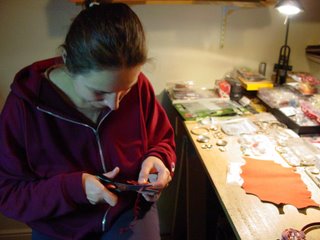Exploring the field of studio jewelry and jewelers, working independently to create jewelry that encompasses art, design, and craft.
Sunday, November 26, 2006
Lack of blogs
In the meantime, Guild.com is featuring me online and in their print catalog, along with many other talented jewelers!
Sunday, October 29, 2006
JanosikNY
Then, in 2004, at my first Baltimore show, Andrea ended up being in an adjacent booth at the show. It was great to have an old friend there with me in the "rookie" section of the show. At the time, she was showing a line of work that incorporated suede inserts into very sleek sanded silver forms. To get an idea, have a look at her website and the bumps group in particular. She has always had impressive craftsmanship. Having spent a considerable number of hours sanding flat silver surfaces myself, I was blown away by how much care she was putting into the pieces.
Since then, she has added a patent leather flower element to her work. It has led her in a less restrained direction as the leather is no longer bound by the silver frames. One of my favorite pieces that she has made recently is this Meadow Bracelet. I love how the bracelet is a sleek silver frame for the leather liner, but how the addition of the flowers scattered on the surface breaks the severity of geometry.
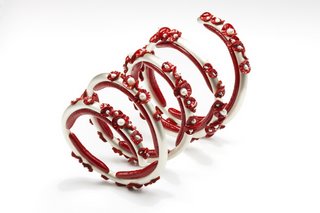
Andrea has a very tidy workspace, which is good because it is also very small. Not uncommon for jewelers here in NY. She had been made many domes of various sizes to be used in necklaces, and other components of her pieces can be seen, ready to be put together. Sometimes I think I have too much space, which allows me to spread bits an pieces of jewelry everywhere!
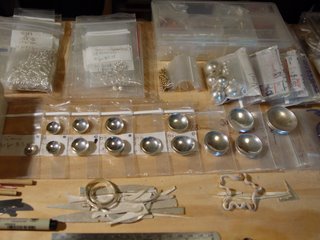
...and the flower after cutting, but before it is compressed and shaped.
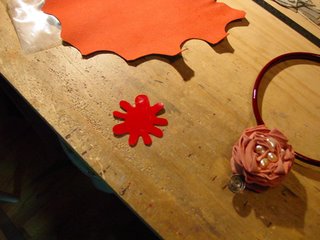 Here are the necklaces that were in progress when I visited, all one-of-a-kind.
Here are the necklaces that were in progress when I visited, all one-of-a-kind.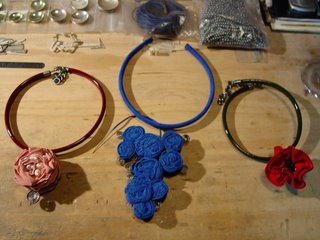 Finally, me modeling one of the new necklaces. This particular one has small pearls nestled in the folds of the flowers and a hammered banding of silver around the flowers. The texture is quite a contrast to the minimalism of her earlier work.
Finally, me modeling one of the new necklaces. This particular one has small pearls nestled in the folds of the flowers and a hammered banding of silver around the flowers. The texture is quite a contrast to the minimalism of her earlier work.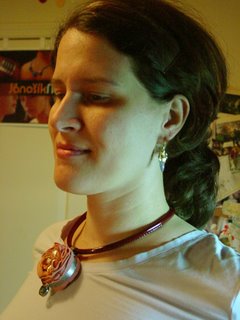 Andrea will be showing her work at the Crafts Park Ave. show at the Park Ave armory on the Upper East Side of Manhattan, this November 30-December 3rd.
Andrea will be showing her work at the Crafts Park Ave. show at the Park Ave armory on the Upper East Side of Manhattan, this November 30-December 3rd.
Friday, September 22, 2006
Katy Beh
Katy also has nerves of steel. Her gallery is located in New Orleans. She has continued on this year by moving ahead and loooking forward optimistically to the future of her home city and her business.
In celebration of a season without hurricanes in New Orleans, she is putting on a Purple, Green and Gold jewelry show. Those are the colors of mardi gras and New Orleans. Even though it isn't the mardi gras season, there is a reason to celebrate nontheless.
So, best wishes to Katy and her city. May they have many reasons to celebrate in the future!
This is the collection I have sent to her:
 If you will be in New Orleans, Katy Beh will be hosting a great party on October 7th for the city's Art for Art's Sake gallery tour. As I understand it, there will be a very loud brass band involved!
If you will be in New Orleans, Katy Beh will be hosting a great party on October 7th for the city's Art for Art's Sake gallery tour. As I understand it, there will be a very loud brass band involved!
Wednesday, September 13, 2006
Early work continues
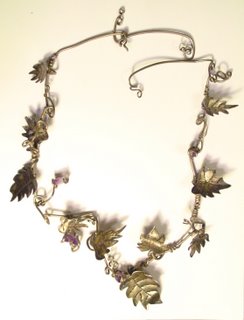 Fortunately, at my high school in Wisconsin, I was able to take classes in art metals. I had an outlet other than my trigonometry notebook in which to expore this obsession. Since, I hadn't yet encountered art from Nepal or Tibet, the art style most near and dear to me at this time was Art Nouveau.
Fortunately, at my high school in Wisconsin, I was able to take classes in art metals. I had an outlet other than my trigonometry notebook in which to expore this obsession. Since, I hadn't yet encountered art from Nepal or Tibet, the art style most near and dear to me at this time was Art Nouveau.This necklace was mabye the fifth piece I made in metal. I like how it is connected it in a way that is very free-form and not fussy. I was about 16 years old and it took me the entire semester to finish.
After high school, I started making sculpture rather than jewelry. I still had a fascination with curls and vines, but also began exploring branches and tree forms.

During my study abroad in Nepal, I made quite a few of these tree-inspired sculptures, like the one at the right. The trees were always somewhat twisting and weather-beaten. Much like I saw when I was in the high altitude regions of the Himalayas.
Most of the time, the jewelry I make is easy to wear. However, I decided to challenge the wearer a little bit. I had a longing to combine the wearibility of the jewelry with sculpture. A necklace that is a bit heavy and substantial and that actually has branches sticking up off of the body.
I returned to the tree theme and also mixed up some the same wax that is used in traditional casting in Nepal. The wax is a mix of beeswax and tree resin, which brough from Nepal with me. It becomes very soft, like clay when heated. Then, as it cools, it becomes hard. It is a bit too sticky to be carved when it is hardened, so most of the shaping is done when soft. Each section is then cast and joined with rivets.

I am calling this necklace the Yunnan Mountain Necklace. It is sterling silver and 18K gold.
Friday, August 18, 2006
Custom
Of all the jewelry I make, the rings are the most tied up with emotion. The couple is usually very nervous and, besides a car, it is the largest purchase many of them have made up to this point. Add to that the fact that this ring will be the first step in their commitment to each other. Often both partners are in involved in selecting the ring. I am very wary of making a custom ring without any input from the person who will be wearing it.
The ideal situation when doing custom work is for the client to know my work already and want to have a piece in my style. I have made very sleek and symmetrical rings, but in truth, I do the best when the ring is in the style that I use in a lot of my work. For example, all of the curlicues. I make them all the time, so I am really, unusually good at them.
One of the challenges in making the engagement rings is the quest for the stone. In this case, I advised my client that emerald, his girlfriend's favorite stone, is too brittle for everyday wear and also not a good value for the money. So we decided on a tsavorite garnet. Not a stone that is commonly known, it is a very rare garnet that is bright green. In looking for this stone, I had to make contact with all of the people I know in the gem trade. In the size, shape and fine quality I was looking for, nobody had it in stock. Stones were called in from all over, I made the initial selection and ended up with these three for my client to choose from:

He decided to choose the stone on the right. It had the right shape, color and the cut was really beautiful.
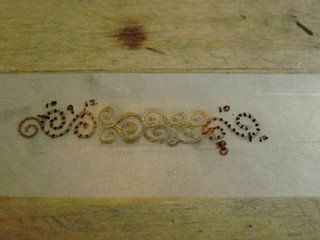 The initial drawing.
The initial drawing. 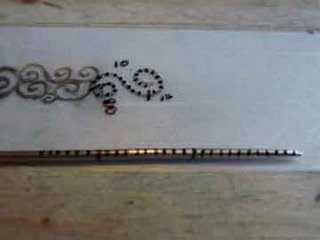 Marking the wire to match the size of the curls. Platinum is an extremely expensive metal, so I try to be precise and conserve every millimeter.
Marking the wire to match the size of the curls. Platinum is an extremely expensive metal, so I try to be precise and conserve every millimeter. The drawings for the two side panels.
The drawings for the two side panels.
Hammering the wire to lengthen and taper it.
Smoothing out the hammer marks with an abrasive wheel.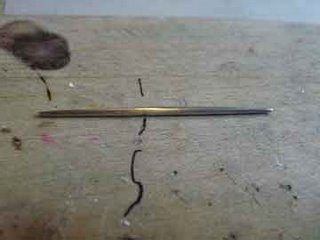 A double taper ready to be bent into an s-curl.
A double taper ready to be bent into an s-curl. 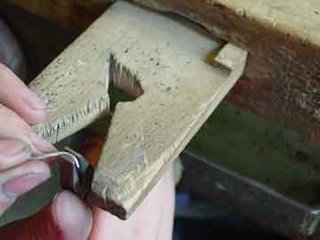 Gently bending the wire into shape.
Gently bending the wire into shape.

After the first stage of bending. As the wire is bent, it becomes work hardened. Think of a paperclip that has been bent back and forth too many times.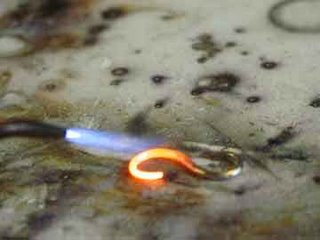 Annealing the curl. Platinum must be heated to a white hot temperature to become malleable again.
Annealing the curl. Platinum must be heated to a white hot temperature to become malleable again. After the second bending.
After the second bending.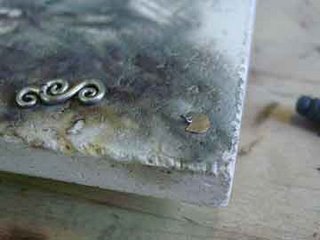 All of the curls are then pieced together one by one. Here is one full s-curl and a half curl that I will join using platinum solder.
All of the curls are then pieced together one by one. Here is one full s-curl and a half curl that I will join using platinum solder. Each curl is bent carefully and the design is consulted to make sure it is the correct size, shape and proportion.
Each curl is bent carefully and the design is consulted to make sure it is the correct size, shape and proportion. Almost finished fitting the curls together.
Almost finished fitting the curls together. The flat arrangement of curls is bent around a steel tool called a ring mandrel.
The flat arrangement of curls is bent around a steel tool called a ring mandrel. The stone must be fitted exactly into the setting for a tight and secure fit. At this point I become very familiar with every little idiosyncrasy in the faceting of the stone. In the world of jewelers, a tenth of a millimeter is quite large!
The stone must be fitted exactly into the setting for a tight and secure fit. At this point I become very familiar with every little idiosyncrasy in the faceting of the stone. In the world of jewelers, a tenth of a millimeter is quite large!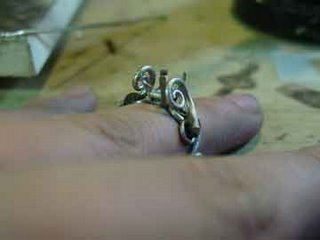 The side panels needed to be integrated into the pattern that was underlying it. At this point, the side panels were stuck on with wax to plan how they would be fit for soldering onto the ring.
The side panels needed to be integrated into the pattern that was underlying it. At this point, the side panels were stuck on with wax to plan how they would be fit for soldering onto the ring. I got very involved with the process after that point and concentrated on the work rather than the photos. Here it is, after many minute adjustments and some obsessive hours of sanding and polishing.
I got very involved with the process after that point and concentrated on the work rather than the photos. Here it is, after many minute adjustments and some obsessive hours of sanding and polishing.
Tuesday, August 08, 2006
A Pin...Transformed
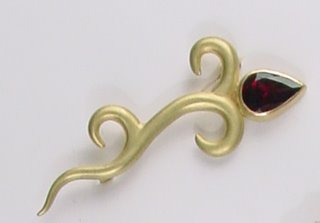
After having this pin for a year plus, I was glad to rearrange it and make it more vibrant, and yes, embellished. I often get chastised for cutting apart old pieces, but sometimes it can be a very rejeuvenating and creative process. Why not go back and continue those pieces that didn't gel the first time?
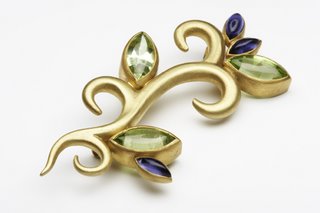
Completely worth it, right?
This pin was so dramatically transformed that it is now going to be a pin that I showcase in advertising.
Saturday, July 29, 2006
ACC Application Time
The most coveted booths at the show are those that are for both portions of the show. It is very important for every established and emerging artist to be seen by both the galleries and the members of the public that hold this show in high regard. People travel from all over the Northeast and from across the country to collect directly from the most talented artists in all mediums.
For the artists, it sounds wonderful, right? Of course it is, but there is a catch. There is simply not enough space for all of us. This is doubly true when it comes to the jewelry section. Add to that the fact that we must re-apply each and every year. It is easy to imagine the effort that goes into making new work for the slides, having the work photographed, making sure the color balance is correct, and then finally submitting the application. Some artists analyze everything about how those five slides will look together on the screen.
I was recently reminiscing about my first ACC show with a friend. We felt so happy to be there. It was thrilling and intimidating at the same time to be there on the same floor as those artists we had seen in famous galleries, museum collections and magazines. I was very sure that someone would notice that I wasn't quite as brilliant as those famous artists. Whether we were feeling euphoria or panic, we managed to make it through, make friends and actually start working with some really great galleries.
So, as the deadline approaches, I wait for my own results and look forward to seeing how the jurying will shake out. Good luck everyone!
Thursday, July 13, 2006
New Image, New Work
Sometimes I allow myself to be hung up on the mechanisms of a piece. My sketchbook is filled with elaborate drawings of mechanisms that are beyond complicated. I usually find, however, that once I start the project and the pieces are actually laid out before me, the solution can suggest itself. Simple is always better, as in this necklace.
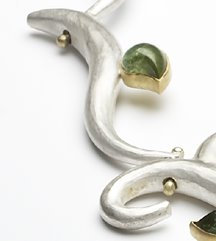 These photos are by Ron Boszko. We spent a day last week photographing some of my special pieces at his studio in Manhattan and I am very excited by the results.
These photos are by Ron Boszko. We spent a day last week photographing some of my special pieces at his studio in Manhattan and I am very excited by the results.
Friday, July 07, 2006
Idea Incubation
The original idea for the piece has been in my sketchbook for nearly a year as well. I spent some time being hung up on the idea that the necklace needed to be made entirely in 18K to complement such a special set of stones. Well, I think I would have been waiting for quite a number of years waiting for the budget for that amount of gold to appear.
I had even made a clay model, but for some reason I was yet to put hammer to metal. Eventually, the clay model had to be put away to make room for other projects.
Two weeks ago, with a photo deadline approaching, I made the decisive step of forging the first link. I was easily able to slip into the state of creative meditation known as flow, and the necklace came together in an elegant and simple way.
Photos to come next Tuesday!
Wednesday, June 21, 2006
Jeweler? Metalsmith? Goldsmith?
Speaking of the word jeweler, it is a matter of some controversy in the field. To the understanding of most people, jewelers are those that sell jewelry. Some that are makers of jewelry would call themselves jewelers, but depending on the particular preference of the maker, studio jeweler, metalsmith, goldsmith and silversmith might also be used. Then of course, there are the specialized titles of engraver, setter, caster.
I have been inspired by the very successful blog, www.englishcut.com, to talk about some of the nuances of the jewelry trade. As with the trade of tailoring, there is much that goes on in the studios and workshops of jewelers that is a mystery to those outside of that world. As a maker of jewelry that is produced by my own hands, I want to share the language of our materials, methods and our inspiration.
I have also been urged by blogging potter friend Mary Anne Davis to share some insights into my own life and work, so mabye I'll be able to loosen up and share some of that too!
